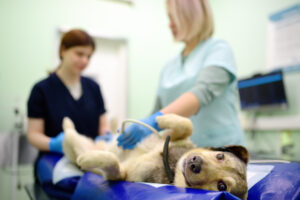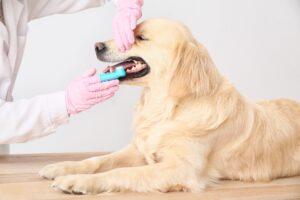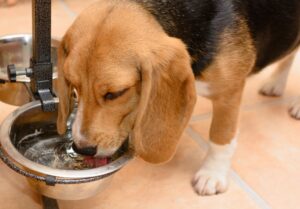What is Health Testing for Dogs?
 From the best food to daily walks to routine vet visits, we do everything we can to keep our furry friends happy and healthy. So what other things can a responsible dog owner do to ensure their pup is in the best health possible? One important part of holistic pet care is regular health testing. Health testing allows vets to get a better picture of a dog’s current condition and can even help identify problems that may pop up down the road. In this post, we’ll explain why health testing for dogs is important, the most popular health tests for dogs, the benefits of health tests for dogs, and where to get health testing for your dog in Tampa.
From the best food to daily walks to routine vet visits, we do everything we can to keep our furry friends happy and healthy. So what other things can a responsible dog owner do to ensure their pup is in the best health possible? One important part of holistic pet care is regular health testing. Health testing allows vets to get a better picture of a dog’s current condition and can even help identify problems that may pop up down the road. In this post, we’ll explain why health testing for dogs is important, the most popular health tests for dogs, the benefits of health tests for dogs, and where to get health testing for your dog in Tampa.
Importance of Health Testing
Health testing for dogs is essential for owners who want to stay on top of any issues with their dog’s health beyond a yearly physical examination. Health testing makes detecting the underlying cause of disease much easier and can detect early signs of certain diseases before the dog begins showing symptoms. This results in better treatment outcomes and better quality of life for the dog.
Health testing is even more important here in hot, humid Tampa, as our climate conditions are a breeding ground for mosquitoes, carriers of dreaded heartworms. Exposure to Florida’s diverse wildlife can also introduce pathogens to your dog that health testing may reveal.
Popular Types of Health Tests for Dogs
Genetic Testing
Genetic testing can identify hereditary conditions in your dog before symptoms emerge, allowing you to begin treatment much earlier and prepare for what’s ahead. Genetic testing is of particular importance to breeders, as they are always searching for dogs with the best genes to pass along to offspring.
Blood Tests
Just like in humans, blood tests are vital in monitoring a dog’s health status. Blood tests can identify infections, anemia, diabetes, kidney disease, liver disease, and more. They are usually a part of a dog’s annual checkup, but can be done more frequently for dogs with chronic conditions.
Heartworm Testing
As mentioned above, Tampa is a breeding ground for heartworm-carrying mosquitoes. Getting an annual heartworm test for your dog, along with a monthly preventive medication, will protect your pooch from this debilitating condition.
Urinalysis
An analysis of your dog’s urine can reveal a lot about their health, including kidney function, the presence of any bacteria, and underlying issues with their metabolic and organ health.
Fecal Testing
Intestinal parasites are a big problem in dogs, which is why regular fecal testing is a great tool vets have to identify parasites like worms and giardia. Puppies and dogs coming from crowded, unsanitary conditions are particularly susceptible to parasites, and some can even be passed on to humans or other pets.
X-rays and Ultrasound
Common imaging tests done in veterinary offices include x-rays (radiographs) and ultrasounds. These imaging tests are crucial when identifying and diagnosing problems with the bones, joints, or internal organs. Since some fractures, tumors, or other problems can’t be found during a standard physical examination, imaging tests can be lifesaving.
Benefits of Health Testing
- Early Detection: Early detection of health problems allows for quick treatment and more positive treatment outcomes
- Prevention: When a health test identifies an issue, preventive measures can be taken to stop symptoms from emerging or becoming worse
- Informed Decisions: Breeders always need to be 100% aware of everything about the dogs they are breeding and selling so they can pass accurate information along to their buyers
- Peace of Mind: Knowing that you’re doing everything you can do to protect your dog’s health, plus have the information to tackle issues straight on when they do emerge, can provide great peace of mind and relief from anxiety
Health Testing for Your Dog in Tampa
Health testing is an important part of both preventive and acute care here at Affordable Pet Hospital in Tampa. We use state-of-the-art diagnostic tools, including a full range of health tests, to get a clear picture of your dog’s current health, needs, and any potential future concerns. To schedule health tests or a routine wellness checkup for your dog in Tampa, contact us at 813-991-9898 or request an appointment online.

 Dermatitis is an inflammatory skin condition, some types of which are estimated to affect up to 30% of all dogs. It causes excessive itching and discomfort if left untreated. While dermatitis is a lifelong condition for pups, proper treatment and management can significantly reduce symptoms and increase quality of life. In this post, we’ll take an in-depth look at what dermatitis is, how to recognize it, and what steps you can take to treat and prevent it.
Dermatitis is an inflammatory skin condition, some types of which are estimated to affect up to 30% of all dogs. It causes excessive itching and discomfort if left untreated. While dermatitis is a lifelong condition for pups, proper treatment and management can significantly reduce symptoms and increase quality of life. In this post, we’ll take an in-depth look at what dermatitis is, how to recognize it, and what steps you can take to treat and prevent it. When your dog is pregnant, you want to do everything you can to make sure they’re healthy and happy. There’s a lot to prepare for and think about leading up to the big day, and for most dogs, pregnancy and birth are smooth sailing. However, there are times when the safest option for a dog’s birth is via cesarean section (C-section). In fact,
When your dog is pregnant, you want to do everything you can to make sure they’re healthy and happy. There’s a lot to prepare for and think about leading up to the big day, and for most dogs, pregnancy and birth are smooth sailing. However, there are times when the safest option for a dog’s birth is via cesarean section (C-section). In fact, 
 If your dog has even thrown up
If your dog has even thrown up  At Affordable Pet Hospital in Tampa, we are aware of the recent media reports about an emerging unknown canine respiratory illness affecting dogs across various states in the U.S., including Florida. During this time of year, it’s not unusual to see an uptick in respiratory infections among dogs. However, this particular illness is drawing attention due to its undefined nature, lacking a specific name, clear cause, or established treatment protocol.
At Affordable Pet Hospital in Tampa, we are aware of the recent media reports about an emerging unknown canine respiratory illness affecting dogs across various states in the U.S., including Florida. During this time of year, it’s not unusual to see an uptick in respiratory infections among dogs. However, this particular illness is drawing attention due to its undefined nature, lacking a specific name, clear cause, or established treatment protocol. As veterinarians with years of experience treating our furry friends, one of the most common concerns we hear from pet owners is about their dog’s
As veterinarians with years of experience treating our furry friends, one of the most common concerns we hear from pet owners is about their dog’s  As pet owners, we always want the best for our furry friends. Their
As pet owners, we always want the best for our furry friends. Their  As pet owners, we often focus on providing our furry companions with proper nutrition, exercise, and
As pet owners, we often focus on providing our furry companions with proper nutrition, exercise, and  Kidney disease is fairly common in humans, but can dogs really suffer from this condition? The answer is a resounding yes, and it’s more common than you might think. Up to 10% of dogs are affected by this condition, according to the
Kidney disease is fairly common in humans, but can dogs really suffer from this condition? The answer is a resounding yes, and it’s more common than you might think. Up to 10% of dogs are affected by this condition, according to the 